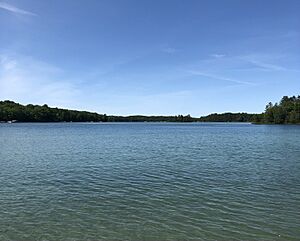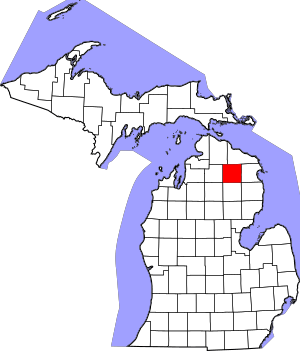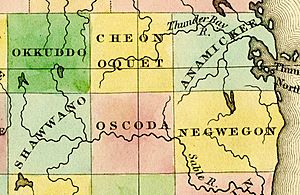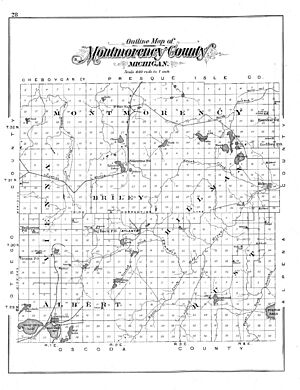Montmorency County, Michigan facts for kids
Quick facts for kids
Montmorency County
|
||
|---|---|---|

|
||
|
||

Location within the U.S. state of Michigan
|
||
 Michigan's location within the U.S. |
||
| Country | ||
| State | ||
| Founded | 1840 (created) 1881 (organized) |
|
| Named for | House of Montmorency | |
| Seat | Atlanta | |
| Largest settlement | Lewiston Hillman (incorporated) |
|
| Area | ||
| • Total | 563 sq mi (1,460 km2) | |
| • Land | 547 sq mi (1,420 km2) | |
| • Water | 16 sq mi (40 km2) 2.8%% | |
| Population
(2020)
|
||
| • Total | 9,153 | |
| • Density | 18/sq mi (7/km2) | |
| Time zone | UTC−5 (Eastern) | |
| • Summer (DST) | UTC−4 (EDT) | |
| Congressional district | 1st | |
Montmorency County is a county located in the state of Michigan. In 2020, about 9,153 people lived there. This makes it one of the least populated counties in Michigan's Lower Peninsula. The main town, or county seat, is Atlanta.
Montmorency County is part of Northern Michigan. Its rivers and lakes drain into Lake Huron. The Thunder Bay River flows through the county and empties into Lake Huron at Alpena.
Contents
History of Montmorency County
How Montmorency County Got Its Name
The Michigan government first created the county in 1840. It was called Cheonoquet County back then. This name honored a famous Chippewa (also known as Ojibwa) Chief named Cheonoquet. His name meant "Big Cloud." Chief Cheonoquet signed important treaties in 1807, 1815, 1825, and 1837.
On March 8, 1843, the county's name changed to Montmorency County. It was first spelled "Montmorenci." Historians believe the name comes from French-Canadian influences. A French Duke of Montmorency bought a leadership role in Canada. Also, the first archbishop of Canada was Montmorency-Laval. Both could have inspired the county's name. The name Montmorency likely means "Mountain Moor." This suggests a boggy or marshy land on top of a broad hill.
When Montmorency County Was Formed
The county was officially organized in 1881. When it was formed, some land came from Cheboygan and Alpena counties. Three townships were divided: Briley, Montmorency, and Rust.
By 1901, more townships were added. These included Albert, Hillman Township, and Wheatfield. The first county seat was Brush Creek, which is now known as Hillman. In 1891, the county seat moved to Atlanta.
Geography and Nature
Land and Water Features
Montmorency County covers about 563 square miles. Most of this area, 547 square miles, is land. The remaining 16 square miles (about 2.8%) is water. Even though it's in Michigan's Lower Peninsula, it's considered part of Northern Michigan.
Much of the county is covered by state forests. There are many lakes, like Long Lake. Ancient glaciers shaped the land, creating a special natural environment. A large part of the area is a sandy plain with hills, pine forests, and hardwood forests. The glaciers also formed the many large lakes found here.
Neighboring Counties
Montmorency County shares borders with several other counties:
- Presque Isle County to the northeast
- Alpena County to the east
- Alcona County to the southeast
- Oscoda County to the south
- Crawford County to the southwest
- Otsego County to the west
- Cheboygan County to the northwest
Main Roads and Transportation
The county has a few main highways:
 M-32
M-32 M-33
M-33
 Bus. M‑32
Bus. M‑32 F-01
F-01 F-21
F-21
Interestingly, Montmorency County does not have any traffic lights. There are only a few blinking lights at highway intersections.
Communities in Montmorency County
Villages and Towns
- The only village is Hillman.
Main Census-Designated Places
These are areas that the U.S. Census Bureau defines for gathering population data:
- Atlanta (the county seat)
- Canada Creek Ranch
- Lewiston
Local Townships
Montmorency County is divided into several townships:
- Albert Township
- Avery Township
- Briley Township
- Hillman Township
- Loud Township
- Montmorency Township
- Rust Township
- Vienna Township
Other Small Communities
You can also find these smaller, unincorporated communities:
- Big Rock
- Hetherton
- Vienna Corners
Economy and Jobs
Farming is important in Montmorency County, especially for dairy products and dry beans. However, most jobs are in the service industry and retail. These jobs often support tourism. People visit the area for boating, fishing, and other outdoor activities.
Fun Things to Do and See
Outdoor Adventures
- Elk Capital: Atlanta is known as the "Elk Capital of Michigan." Each year, during elk hunting season, the largest elk hunted are shown off at a special "buck pole" in the town square. When it's not hunting season, many locals and tourists enjoy driving around the wilderness to spot these beautiful animals.
- Fishing: The county is a great place for fishing. You can find Rainbow trout, brook trout, steelhead, perch, bass, and other small fish. Many people enjoy fly fishing and angling in the county's streams and rivers.
- Deer Hunting: Hunting White tail deer is a very popular activity. The opening day of deer season (November 15) is even like a holiday for some residents, with schools closing. Much of the land in Montmorency County is public, making it a favorite spot for hunters.
- Winter Sports: When it snows, Snow shoeing, cross-country skiing, and snow mobile riding are popular. The Sno*Drift rallying race, a car race on snowy roads, happens in February.
- Mushroom Hunting: Hunting for morel mushrooms is a fun local hobby that also brings many tourists to the area.
Trails and Events
- ORV/ATV and Snowmobile Trails: Montmorency County has some of the best trails for off-road vehicles (ORVs), all-terrain vehicles (ATVs), and snowmobiles. Some maps even call areas "trail mazes." Montmorency County is one of the few counties where ATVs are allowed on public county roads. This makes it easy for riders to get to Hillman, Atlanta, and Lewiston for fuel, food, and places to stay. The main trail system includes a scenic elk tour and different levels of ATV trails.
- Sled Dog Races: Every year, sled dog races are held near the end of January at Clear Lake State Park.
Local News
The main newspaper for Montmorency County is the Montmorency County Tribune.
Protecting Endangered Species
Montmorency County is home to a very rare insect called the Hungerford's crawling water beetle. This beetle is one of the most endangered species in the world! It lives in only five places globally, and two of those are in Montmorency County. Both locations are inside the Mackinaw State Forest.
In 1989 and 1996, adult beetles were found along the East Branch of the Black River. Then, in July 1999, six more adult beetles were found in Van Hetton Creek. This was an exciting discovery because it meant the beetles were living in a new place. The Hungerford's crawling water beetle was officially listed as endangered on March 7, 1994. Finding them in Van Hetton Creek gives hope that more of these rare beetles might be found elsewhere in Montmorency County.
See also
 In Spanish: Condado de Montmorency para niños
In Spanish: Condado de Montmorency para niños




